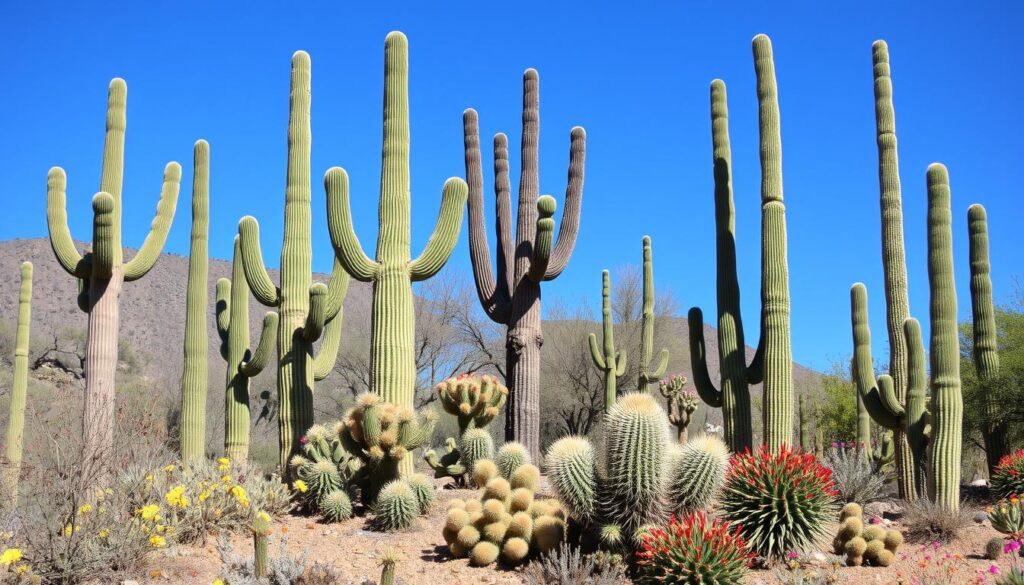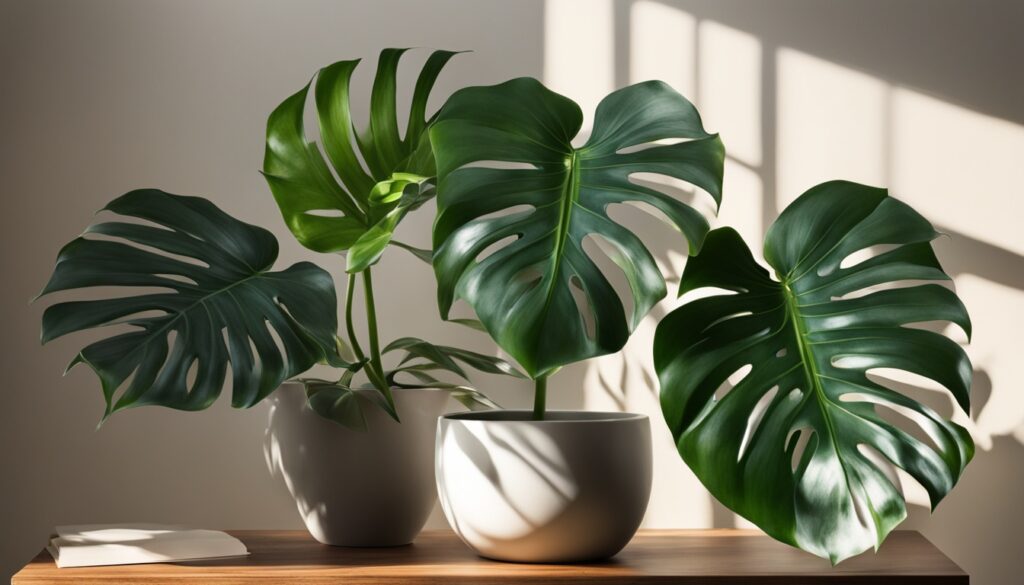Ever wondered about the amazing variety of cactus trees? There are over 1,750 species across the Americas. These plants have fascinated gardeners and nature lovers. Each type, from the tall Saguaro to the climbing Mistletoe Cactus, has its own special charm.
They are well adapted to survive in harsh desert conditions. But how much do you know about these common cactus trees and their interesting traits? Get ready to learn about these fascinating succulents and their amazing survival skills.
Key Takeaways
- Cacti are native to the Americas, ranging from Patagonia to western Canada, and can live for hundreds of years in the wild.
- Cactus trees come in a wide variety of shapes, sizes, and colors, making them popular for indoor and outdoor gardening.
- Unique adaptations like water storage and waxy coatings allow cacti to thrive in arid desert climates.
- Saguaro Cactus, Organ Pipe Cactus, and Cereus Cacti are some of the most iconic cactus tree species.
- Proper care, including watering, soil, and light requirements, is essential for successfully growing cactus trees.
Understanding Cactus Trees and Their Characteristics
Cactus trees have evolved amazing ways to survive in harsh, dry places. Their thick, fleshy stems act as water tanks, helping them go without water for a long time. They also have special roots that grab water when it rains.
Unique Adaptations of Cactus Trees
The spines on cactus trees are very important. They help keep water in and keep animals away. This lets the plants save water in the dry desert climate. The waxy layer on their stems also helps keep water from evaporating.
Growth Patterns and Life Cycles
Cactus trees grow in many ways, from tall to small. They live a long time, sometimes over 200 years. This shows how well they can store water and adapt to their homes.
Natural Habitats and Distribution
Cacti live in deserts, but also in tropical forests and other places. The Cactaceae family has over 1,750 species, found from South America to western Canada. Mexico has the most cactus species, showing their wide variety.
“Cacti have evolved an array of unique adaptations that allow them to thrive in some of the harshest environments on Earth.”
Types of Cactus Trees in the Desert Southwest
The Desert Southwest covers parts of Arizona, New Mexico, and Texas. It’s home to many iconic cactus trees. These plants thrive in the hot, dry conditions, supporting local wildlife.
The Saguaro (Carnegiea gigantea) is a famous cactus tree. It can grow up to 40 feet tall and live over 150 years. You can find it in southern Arizona and western Sonora, Mexico, and parts of California and Sinaloa.
The Organ Pipe Cactus (Stenocereus thurberi) can grow up to 25 feet tall. It looks like organ pipes because of its unique shape. You’ll find it mainly in Arizona’s Organ Pipe Cactus National Monument.
The Opuntia genus, known as Prickly Pears and Chollas, is also common here. The Buckhorn Cholla can grow up to 13 feet tall. The Teddy Bear Cholla and California Cholla can reach lengths of up to 9 feet.
Other notable cacti include the Key-Tree Cactus, the Greater Antillean Tree Cactus, and the Royen’s Tree Cactus. They all grow to impressive heights.
These cactus trees are not just beautiful. They also support a wide range of desert wildlife. They provide food and shelter, making them essential to the ecosystem.
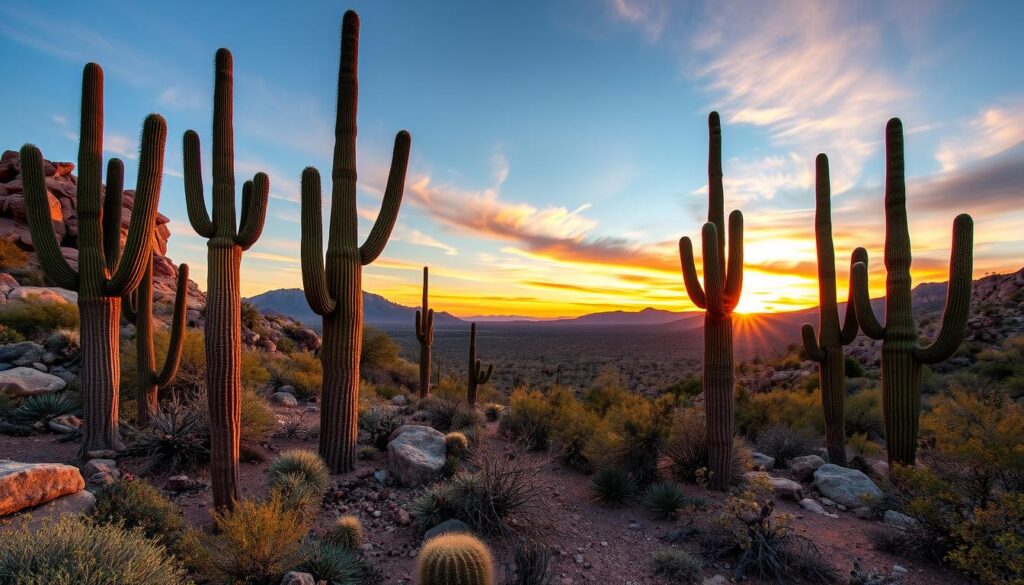
Saguaro Cactus: The Giant of the Desert
The Carnegiea gigantea, or saguaro cactus, is a symbol of the American Southwest. It’s the largest cactus in the United States. These desert icons can grow up to 50 feet tall and live over 200 years.
Physical Characteristics and Growth
Saguaros grow slowly, taking 50 years to get their first arm. They can grow up to 45 feet tall. The tallest one was 78 feet tall.
Over time, a saguaro can get over 50 arms. Each arm shows decades of growth.
- Saguaros take 10 years to grow just 1 inch.
- By 70 years, they can be 6.5 feet tall and start flowering.
- At 95-100 years, they can be 15-16 feet tall and have their first arm.
- The largest saguaro was 45 feet tall and 200 years old.
Habitat Requirements
The Carnegiea gigantea loves the hot, dry Sonoran Desert. It’s found in southern Arizona, California’s Whipple Mountains, and western Sonora, Mexico. They need full sun and well-draining soil to live.
Cultural Significance
The saguaro cactus is important to the indigenous people. It’s the Arizona state flower and a desert icon. It helps birds nest and feeds desert animals.
Saguaros are key to the Sonoran Desert’s balance. They play a big role in the ecosystem.
“The saguaro cactus is a living symbol of the American Southwest, embodying the rugged beauty and resilience of the desert landscape.”
Organ Pipe Cactus: Nature’s Musical Design
In the Sonoran Desert, the Organ Pipe Cactus (Stenocereus thurberi) stands out. It looks like an organ’s pipes and can reach 25 feet tall. You can find it mainly in the Organ Pipe Cactus National Monument in southwest Arizona.
This cactus is a wonder of nature. Its stems grow from one base, making it look like a pipe organ. It’s not just beautiful; it also helps many animals, like the cactus wren, silky flycatchers, vireos, and black phoebes.
The Organ Pipe Cactus National Monument was created in 1937. It’s a place where you can see this amazing plant and learn about its importance. You can camp, hike, or just enjoy the views of the cacti along the South Puerto Blanco road.
Exploring the desert, you’ll see how strong and adaptable this cactus is. It’s a living sculpture that shows the beauty of nature. It’s a must-see for anyone interested in the American Southwest’s natural wonders.
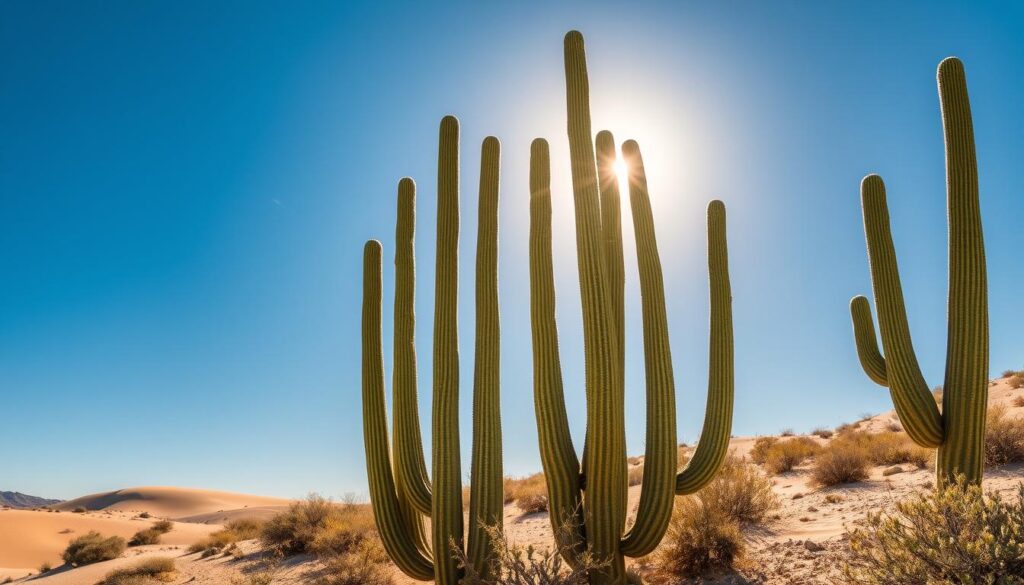
“The Organ Pipe Cactus is a true marvel of nature, with its multiple stems growing from a single base, creating a distinctive architectural form that seems to mimic the symmetry and grandeur of a pipe organ.”
Exploring the Organ Pipe Cactus National Monument
The Organ Pipe Cactus National Monument is full of things to do. You can camp, hike, or just enjoy the desert views. There’s something for everyone.
- Campsites with native flora, including palo verde and organ pipe cactus
- The 5-mile roundtrip Victoria Mine hike through the desert scenery
- The South Puerto Blanco road, just 1 mile north of the Mexican border
- The Pinacate Biosphere Reserve, known for its scrubby, dry landscapes
| Attribute | Value |
|---|---|
| Organ Pipe Cactus National Monument Established | 1937 |
| Organ Pipe Cacti Exclusive to the Monument | Yes |
| Bird Species in the Region | Cactus wren, silky flycatchers, vireos, black phoebes |
| Rattlesnake Species | Western diamondback |
| Tragic Incident | Ranger Kris Eggle murdered in 2002 |
Cereus Cactus Varieties and Features
Cereus cacti are large, tree-like plants found mainly in Latin America. Some varieties are also found in the American Southwest. The night-blooming cereus and Peruvian apple cactus are well-known. They have unique features and growing needs.
Popular Cereus Species
The night-blooming cereus and the Peruvian apple cactus are famous. These columnar cacti can grow up to 60 feet tall. They stand out against desert backdrops.
Growing Requirements
- Cereus cacti need full sun and well-draining soil. They require little water.
- They can handle temperatures as low as 25°F for short times. This makes them good for zones 9, 10, and 11.
- Using a balanced, water-soluble cactus fertilizer helps them grow well.
Common Issues and Solutions
Cereus cacti are mostly easy to care for. But, they can face problems like too much water and pests. It’s important to adjust watering and use the right pest control to keep them healthy.
“The bloom season of the cereus cactus is in spring and summer, and they can tolerate temperatures as low as 25°F for short periods.”
Cereus cacti are amazing for their size and unique looks. Knowing how to care for them helps gardeners enjoy their beauty. These plants show the amazing diversity and adaptability of cacti.
Exploring Cylindropuntia Species
In the desert Southwest, the Cylindropuntia species, or cholla cacti, are quite fascinating. They are known for their detachable, barbed spines. These spines can easily pierce the skin, earning them names like Jumping Cholla (Cylindropuntia fulgida) and Teddy Bear Cholla (Cylindropuntia bigelovii).
Cylindropuntia cacti are common in the Sonoran and Mojave deserts. They can grow up to 15 feet tall. Their stems are segmented and cylindrical, and they have vibrant flowers in yellow, orange, and magenta.
These cacti are important in desert ecosystems. They provide shelter and food for animals, attract pollinators, and help keep the soil stable. But, they face threats from climate change, habitat loss, and illegal collection. This makes their conservation crucial.
If you want to grow these cacti at home, they need minimal care. They thrive in well-draining soil and lots of sunlight. Their roots are shallow but wide, helping them absorb water and anchor in the soil.
| Cholla Cactus Species | Distinguishing Features | Habitat and Distribution |
|---|---|---|
| Cylindropuntia echinocarpa (Silver Cholla) | Segmented, flattened stems covered in sharp spines; vibrant yellow to orange bell-shaped flowers | Primarily found in the southwestern United States and northwestern Mexico |
| Cylindropuntia imbricata (Cane Cholla) | Cylindrical, fleshy stems up to 8 feet tall; purple or magenta flowers in late spring or early summer | Common in New Mexico, with a wide distribution in the southwestern United States |
| Cylindropuntia bigelovii (Teddy Bear Cholla) | Densely covered in soft, white spines that resemble fur; vibrant magenta flowers | Native to the Sonoran and Mojave deserts of the southwestern United States and northwestern Mexico |
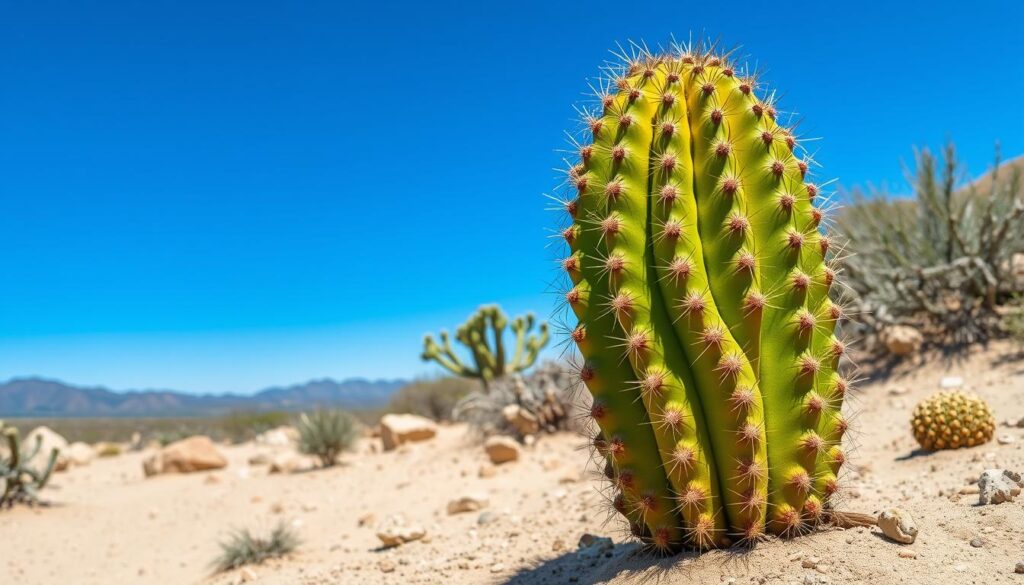
The diverse Cylindropuntia species in the desert Southwest are fascinating. They show the amazing adaptations and importance of these iconic cactus trees.
Essential Care Guide for Cactus Trees
Cactus trees are known for their toughness and unique looks. They need little care but do well with the right attention. These plants are great for the UK’s climate, making them popular for both indoor and outdoor gardens.
Watering Requirements
Cacti and succulents, like cactus trees, store water in their stems and roots. This helps them survive long without water. Water them rarely, letting the soil dry out fully before watering again. Use warm rainwater instead of tap water to avoid mineral buildup.
Soil and Fertilization
Cactus trees do best in soil that drains well, like mixes made for cacti and succulents. Use a mix with sand and grit for the best drainage. Feed them a cactus-specific fertilizer every month during the growing season. This helps them grow strong, fight off diseases, and bloom better.
Light and Temperature Needs
Cactus trees love lots of sunlight but can get too much. They do well in partial shade too. They handle high temperatures but need protection from frost. Keep them cool at night, between 8°C and 10°C, in autumn and winter.
| Care Aspect | Recommendation |
|---|---|
| Watering | Water infrequently, allowing soil to dry completely between waterings. Use tepid rainwater. |
| Soil | Use well-draining, gritty cactus or succulent soil mix, such as Westland Cacti and Succulent Potting Mix. |
| Fertilization | Feed monthly during the growing season with a cactus-specific fertilizer. |
| Light | Provide full sun exposure, but be wary of direct sunlight causing discoloration. |
| Temperature | Tolerate high temperatures, but protect from frost and provide 8°C to 10°C nighttime temperatures in autumn and winter. |
Follow these care tips for the best cactus care and growth of your cactus trees in the UK. They are easy to care for and add beauty to any space, indoors or outdoors.
Common Challenges in Growing Cactus Trees
Growing cactus trees comes with its own set of challenges. One big issue is overwatering, which can cause root rot. On the other hand, not enough water can make the cacti shrivel and stop growing. It’s important to have good drainage and water them just right.
Another problem is sunburn. When cacti get too much direct sunlight too fast, they can get discolored and scarred. To avoid this, slowly get them used to more sunlight.
| Common Cactus Issues | Preventative Measures |
|---|---|
| Overwatering & Root Rot | Ensure proper drainage and a controlled watering schedule |
| Underwatering & Shriveling | Maintain consistent moisture levels appropriate for the cactus species |
| Sunburn | Gradually expose cacti to increased light levels to allow for acclimation |
| Pest Control | Monitor for common pests like mealybugs, scale insects, and spider mites, and treat accordingly |
Pests can also be a problem, with insects like mealybugs, scale insects, and spider mites being common pests. Keeping an eye out and using the right pest control is key to keeping cactus trees healthy.
Knowing these common challenges and how to deal with them can help growers have thriving cactus trees. These trees can bring beauty and character to any space, indoors or outdoors.
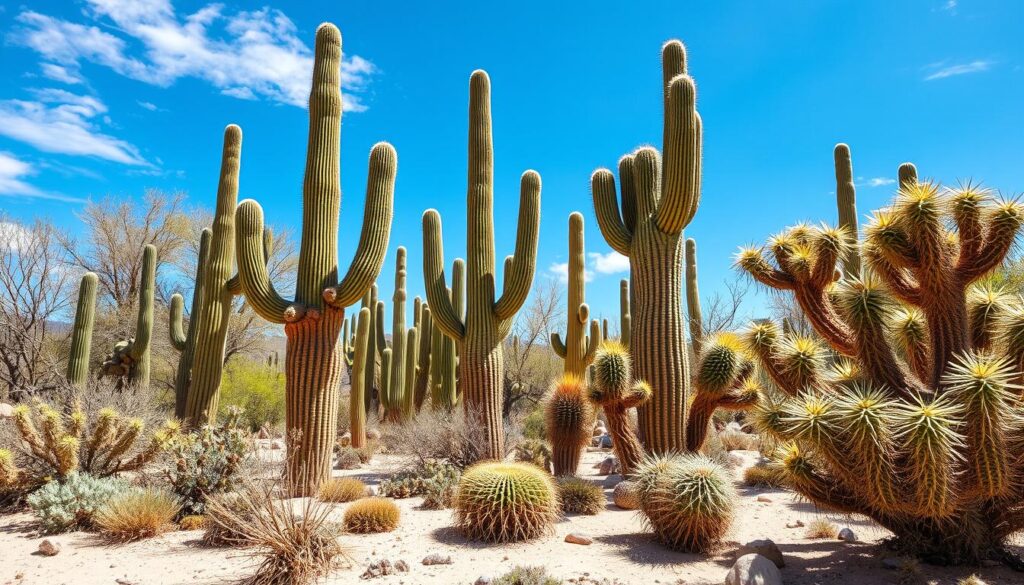
Landscaping with Cactus Trees
Cactus trees are great for xeriscaping and drought-tolerant gardens. They thrive in dry climates and bring unique beauty to desert gardens. Knowing how to design, choose companion plants, and care for cactus trees helps create beautiful, easy-to-maintain landscapes.
Design Principles
When using cactus trees in landscaping, focus on texture and form contrast. Mix their bold shapes with soft desert shrubs or delicate native grasses. Place cactus trees as focal points or in groups for a striking effect. Make sure to plan for their mature size to avoid overcrowding.
Companion Plants
- Other succulents, like agave, aloe, and echeveria, complement cactus trees’ unique shapes.
- Native desert shrubs, such as creosote bush, mesquite, and brittlebush, add natural beauty and interest.
- Drought-tolerant grasses, like blue grama and buffalo grass, bring texture and movement.
Maintenance Tips
Keeping a cactus tree landscape simple is key. Clean up debris and fallen plant material regularly. Use hand-pulling or targeted herbicides to control weeds. Prune only when needed to avoid damage. Plan for the cactus trees’ growth to ensure they have enough space.
By applying these design tips, choosing the right plants, and caring for them, homeowners can create stunning and low-maintenance xeriscaped gardens. These gardens showcase the beauty of cactus trees.
“Cactus trees are the ultimate desert divas, adding drama and resilience to any drought-tolerant landscape.”
Indoor Cultivation of Small Cactus Trees
Want to add desert charm to your home? Small cactus trees are perfect. They’re tough and easy to care for, making great additions to any room.
The Fishbone Cactus can grow up to 6 inches tall and 3 feet long. The Euphorbia, like the African Milk Tree Cactus, can reach over 8 feet tall indoors.
To grow small cactus trees indoors, they need bright, indirect light and well-draining soil. Water them sparingly, letting the soil dry between waterings. Good air flow helps prevent root rot and fungal diseases.
| Cactus Species | Maximum Height | Ideal Temperature Range |
|---|---|---|
| Fishbone Cactus | 6 inches | 12°C-32°C |
| African Milk Tree Cactus | 8 feet | 12°C-32°C |
| Mistletoe Cactus | 12 inches | 12°C-32°C |
Choosing the right cactus species and caring for them properly brings charm to your home. From the Fishbone Cactus to the African Milk Tree, there’s a perfect cactus for every space.
“Cacti are the ultimate low-maintenance houseplants, adding a touch of desert-inspired elegance to any space.”
Whether you’re new to plants or have experience, adding small cactus trees is a great idea. They bring a piece of the Southwest into your home.
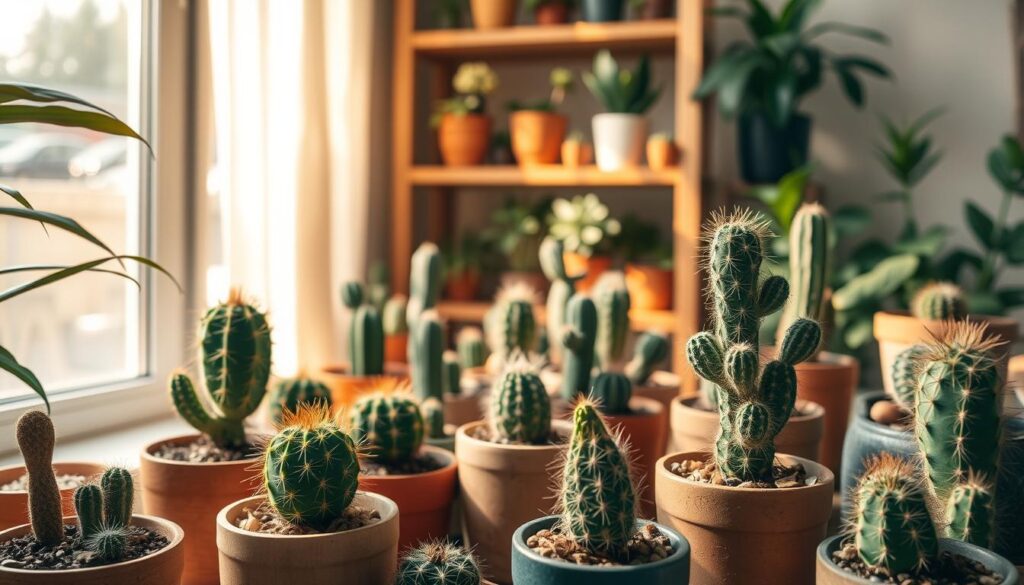
Native and Endangered Cactus Tree Species
Cactus trees come in many unique species, some found only in certain areas and at risk of being lost. The Key Tree-cactus (Pilosocereus robinii) from the Florida Keys and the Santa Cruz Beehive Cactus (Coryphantha recurvata) along the Arizona-Mexico border are great examples.
The Key Tree-cactus was the first U.S. species to go extinct due to rising sea levels. By 2012, half of its population had died from saltwater damage. Hurricane Irma in 2017 made things worse. Sadly, in 2023, scientists confirmed it was extinct in the U.S.
The Pilosocereus robinii in the Florida Keys saw its numbers drop by 84% between 1994 and 2007. These cacti face threats from habitat loss and climate change. We need to act fast to save them.
| Cactus Species | Conservation Status | Key Facts |
|---|---|---|
| Key Tree-cactus (Pilosocereus robinii) | Federally Endangered |
|
| Santa Cruz Beehive Cactus (Coryphantha recurvata) | Threatened |
|
The struggles of these cactus species highlight the urgent need for conservation. We must protect them from habitat loss and climate change. By spreading awareness and taking action, we can help these rare cacti and the important roles they play in their habitats.
Environmental Benefits of Cactus Trees
Cactus trees are not just beautiful, they also help the environment a lot. They are great at pulling carbon out of the air, keeping soil in place, and giving homes to desert animals.
Carbon Sequestration: Cactus trees are amazing at pulling carbon out of the air. They use a special way to make food that helps them grab and hold onto carbon dioxide. This helps fight climate change. There are millions of hectares of cacti around the world, used for food and to capture carbon.
Soil Stabilization: Cactus trees have strong roots that keep the soil from washing or blowing away. This is very important in dry places where soil can easily disappear. Cactus trees act like a shield against soil loss.
- Cactus species like Opuntia are known for their water-use efficiency and ability to thrive in harsh, drought-prone environments.
- Rangeland improvement using spineless cactus has been practiced since the 1930s-1940s in North Africa, notably in Tunisia, to mitigate livestock losses during severe droughts.
Wildlife Habitat: Cactus trees are homes and food for many desert animals. They give birds, insects, and small mammals places to live and eat. This helps keep the desert healthy and full of life.
“Cactus plantations can improve rangelands, enhance biodiversity, sequester carbon, conserve landscapes, mitigate soil erosion, protect water sources, and preserve cultural heritage.”
Cactus trees do a lot of good for the environment. They help with carbon, soil, and animals. As we deal with climate change and soil loss, cactus trees are a key part of the solution.
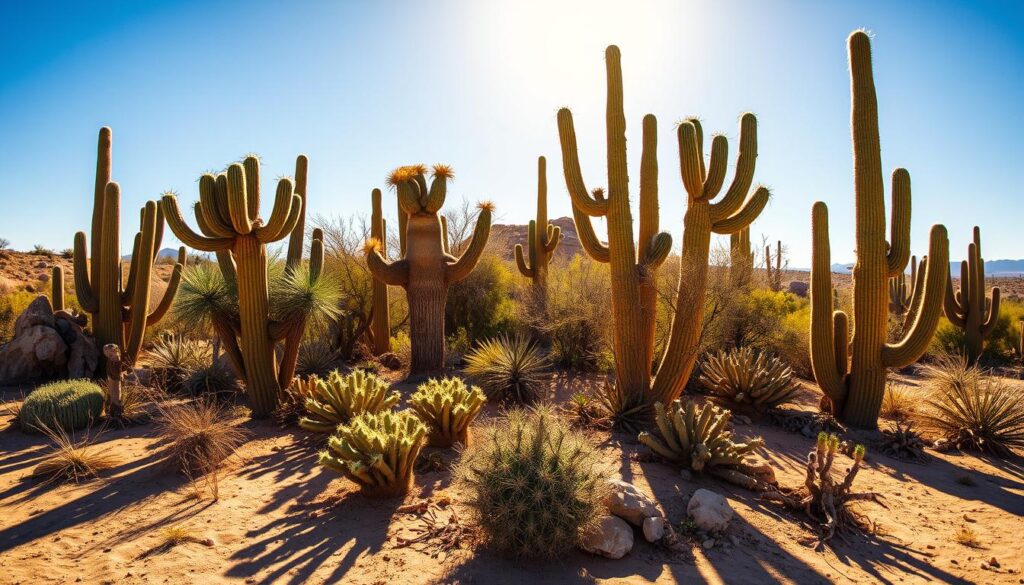
Conclusion
Cactus trees are a diverse and fascinating group of plants. They thrive in the harshest desert ecosystems. From the iconic Saguaro to the unique Organ Pipe, these plants play crucial roles in desert environments.
Understanding their characteristics and how to care for them is key. This knowledge helps us use them in landscape design and indoor gardening.
Appreciating cactus trees’ beauty and resilience is important. We must support conservation efforts for these plants. This helps protect native and endangered species.
By preserving cactus diversity, we protect desert ecosystems and cultural heritage. This is crucial for the future of these remarkable plants.
Cactus trees will continue to inspire and captivate us. They show the natural world’s adaptability and ingenuity. As we learn more about these plants, we deepen our understanding of desert biomes.
We must continue to explore and learn from cactus trees. This knowledge helps us protect their future and the delicate balance of desert ecosystems.
